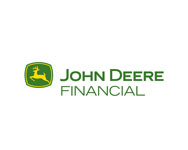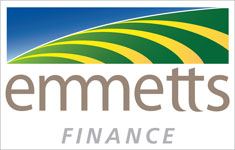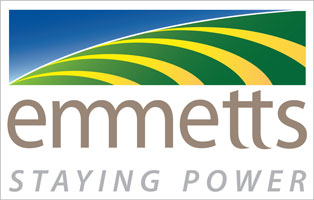
- 12-row, 762 mm (30 in.), 914 mm (36 in.), 965 mm (38 in.), or 1,016 mm (40 in.) spacing
- No lift-assist wheels for improved maneuverability
- Hydraulic wing locks for faster field-to-field transport
- 55-bushel CCS tank
Features
ExactShot™ liquid fertilizer dosing system
NOTE: ExactShot is not available in Australia and New Zealand. Timelines for availability are yet to be determined. The content on the following Sales Manual pages has been compiled for the US/Canada market and therefore may show product information, competitive comparison information, launch dates and marketing and sales activities not relevant for the Australia/New Zealand market. For relevant Australia/New Zealand information, look for New Product Introduction Bulletins published on DealerPath under Tactical Ag Bulletins and What’s New and communicated in the weekly Dealer Newsletters as products become available.
 ExactShot delivers product directly onto the seed in-furrow, eliminating waste between seeds
ExactShot delivers product directly onto the seed in-furrow, eliminating waste between seedsSave on in-furrow fertilizer cost with ExactShot liquid fertilizer dosing system.
High input costs reduce the profitability of any operation. ExactShot can save growers up to 66% of the cost of in-furrow applied nutrients improving their use and efficiency while protecting yield loss along the way. It does this by dosing the product on top of the seed, in the furrow, eliminating the application of product between seeds.
Using less product also results in fewer stops to refill your tanks, improving the overall efficiency of your planting operation.
- Reduce in-furrow fertilizer use up to 66 percent*
- Increase time between starter liquid fertilizer refills in the field
- Maximize nutrient use efficiency by placing product only on the seed
- Enable the potential to add higher-cost or additional applications
*NOTE: Based on internal tests of a prototype ExactShot system performed across 21 farms in six Midwestern states applying a 5.1-cm (2-in) dose on seeds with 15.2-cm (6-in) in-row seed spacing.
How does it work?
When paired with John Deere’s ExactEmerge™ BrushBelt™ technology, the system tracks each seed with infinite accuracy from meter to seed trench, synchronizing each dose with the exact timing of the seed drop. Placing the solenoid directly above the nozzle tip, below the row-unit, adds an additional level of accuracy with each dose not found in similar products.
Two modes of operation
The overall benefits of ExactShot may vary with different products, crop types, soils, etc. In these scenarios, the system can be switched to a more traditional continuous stream of product directly from the display. This gives operators the flexibility to quickly change their application method without the need to change hardware on the planter.
 Dosing mode screen on G5 display
Dosing mode screen on G5 display Continuous mode screen on G5 display
Continuous mode screen on G5 displayAgronomic benefits and savings
Multiple field studies* have shown yields were maintained when the same effective application rate of in-furrow starter fertilizer was dosed directly onto the seed compared to the traditional continuous stream. In some highly responsive instances, as the local rate was increased, yield also increased without adding cost to the application.
By reducing rates, customers can increase their overall profit margins, receiving a higher return on investment with 18.7-L/ha (2-gpa) dosing on-seed compared to 56.1-L/ha (6-gpa) continuous stream. View our ExactShot calculator to see how reduced rates can impact your operation.
Reducing the amount of fertilizer used also reduces the risk of nutrients leaching into nearby rivers, lakes, and ponds.
Additionally, because ExactShot significantly reduces how much product is needed, growers can also gain the ability to use beneficial products in-furrow during planting like biologicals, fungicides, and liquid insecticides that may otherwise be too costly to apply.
*NOTE: Internal tests of a prototype ExactShot system performed across 21 farms in six Midwestern states.
1725C Planter Configurations
 1725C 16Row 30 in. non-CCS planter in the field
1725C 16Row 30 in. non-CCS planter in the fieldThe 1725C planter is available in the following configurations:
- 1725C 12Row – 30 in.
- 1725C 12Row – 36 or 38 in.
- 1725C 12Row – 38 or 40 in.
- 1725C 16Row – 30 in
 1725C 16Row 30 in. CCS planter in the field
1725C 16Row 30 in. CCS planter in the fieldBefore placing an order, please reference the Build and Price tool for any recent revisions to the below information.
Base Code | Description |
355MH | 1725C 12Row 30 in. |
355NH | 1725C 12Row 36 or 38 in. |
355PH | 1725C 12Row 38 or 40 in. |
355RH | 1725C 16Row 30 in. |
Increase productivity with ExactEmerge™ trench delivery system and BrushBelt™ delivery system
It is very challenging to get the crop planted during the optimum planting window or as close to the optimum planting day as possible. Rate-of-yield loss accelerates greatly after the optimum window has passed. This is especially true in the northern U.S. and Canada. ExactEmerge maintains accurate speed placement at higher speeds; growers can avoid missing that peak planting time, thereby helping to get the highest crop yields.
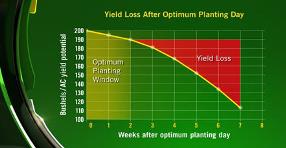 Yield loss after optimum planting day
Yield loss after optimum planting dayWith the BrushBelt trench delivery system, the spacing in the trench does not change from even to uneven terrain. This can be a problem with a traditional seed tube. Seed bounce and ricochet may occur as slopes increases, ultimately decreasing seed spacing performance.
The design of the BrushBelt system provides the best solution for the lowest release of seed to the bottom of the trench. The use of a brush provides the meter with an infinite amount of placement opportunities for each seed. This is what gives producers the confidence that every seed will have the desired spacing that a seed tube cannot provide.
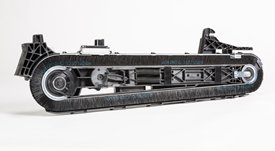 Maintenance-free BrushBelt system
Maintenance-free BrushBelt systemWhen the brush comes around the pulley, it expands and allows the seed to be transferred from the bowl to the brush very easily. The brush then carries the seed down toward the trench, ensuring that there is no movement as it moves down the length of the cartridge.
Once the brush reaches the lower pulley, the BrushBelt system expands again to loosen the grip on the seed, and the centrifugal force releases the seed. Another advantage with the BrushBelt system and cartridge at all speeds up to 16.1 km/p (10 mph) is the ability to match the seed rearward trajectory to the forward ground speed of the planter. This provides a dead drop of the seed with no bounce and no roll at the bottom of the trench.
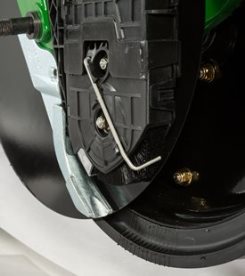 BrushBelt conditioner engages brush bristles
BrushBelt conditioner engages brush bristlesJohn Deere’s ExactEmerge cartridge is self-cleaning. When an operator uses seed treatments or is forced to plant in less than ideal soil conditions, the design of the trench delivery system sheds buildup from the BrushBelt. A brush conditioner is located at the bottom of the cartridge to remove remaining residue and prevent the bristles from sticking together.
 Brush proximity helps clean sensor
Brush proximity helps clean sensorAnother advantage over a seed tube is that the BrushBelt system also acts as a cleaner to the seed sensor compared to a seed tube.
 Sensors for trench delivery system
Sensors for trench delivery system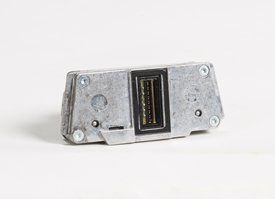 Reflective seed sensor
Reflective seed sensor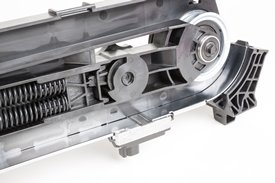 Sensor on trench delivery system
Sensor on trench delivery systemOn all ExactEmerge row-units, each cartridge is equipped with sensors. As the seeds are being delivered through the BrushBelt delivery system controls, they pass the reflective seed sensor. The delivery system slides every seed past the seed sensor to read and send the signal to the controller. The seed sensor and design can provide sensor performance at higher seeds per second with no population adjustment as needed with seed tube sensors. This seed sensor data is actual row-unit performance data. In comparison, seed tube sensors add 10 percent population in soybean planting to adjust for the seeds missed due to placement within the seed tube. The BrushBelt system holds each seed in place until released in the trench, allowing the seed sensor a more accurate read.
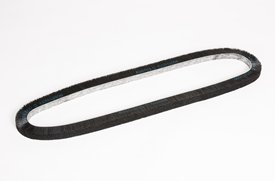 BrushBelt removed from trench delivery system
BrushBelt removed from trench delivery systemThe BrushBelt system requires no maintenance and has a wear life designed to match the wear life of the other wear components. Since operations vary, as do soils and field content, it is recommended to replace the BrushBelt after noticeable wear or decreased performance.
Changing the belt is easy. One latch removes the meter over the trench delivery system. Grab the cartridge by the grip and pull toward the body, releasing it from the electric motor fitting. Lift the trench delivery system up and remove the sensor wiring harness to completely pull the cartridge out of the row-unit.
There are two plastic covers that snap off to uncover the belt; remove the covers and then twist the circular spring tensioner dial with the yellow arrow on it to release the tension on the springs. Once tension has been removed, pull the belt out. It is also recommended to change the stainless-steel wear strip at this time as well, which also slides right out of place without the use of tools.
NOTE: It is recommended to use a talc/graphite mixture with ExactEmerge. Best results have been 80 percent talc and 20 percent graphite. For certain regions and territories, talc and talc/graphite mixes are restricted from use; in this case, use a wax-based fluency agent.
1725C Hopper Options with Electric Drives
 2.7 bushel hopper available from the factory on 1725C planters
2.7 bushel hopper available from the factory on 1725C plantersOverview
John Deere is now offering four new 1725C non-CCS models with three hopper options installed at the factory. The 1725C models with hoppers and electric drives include: 12R30, 12R36/38, 12R38/40, 16R30. The three row hopper options from the factory are 1.6 bu MaxEmerge™ 5e or ExactEmerge™*, 2.7bu ExactEmerge, and 3.0 MaxEmerge 5e.
*ExactEmerge not available on 76.2 cm (30 in.) units
Benefits
- Enables ExactEmerge or MaxEmerge 5e
- Enables the full agronomic suite (pneumatic row cleaners, individual row hydraulic downforce, pneumatic closing wheels)
- Optional ExactRate Liquid Fertilizer
Adding electric drives to the 1725C line brings improved agronomics to even more of our farmers. Adding electric drives to the non-CCS models opens up ExactEmerge. Additionally, peanut farmers and those who cannot use a central commodity system now have access to electric drives through MaxEmerge 5e. The addition of electric drives minimizes skips and doubles, increases spacing accuracy, and enables turn compensations.
Easy fluid transfer with the ExactRate™ fluid transfer system
The ExactRate fluid transfer system pairs planters seamlessly with the ExactRate tractor tanks. It provides an easy connection point to allow transfer from the ExactRate tractor tanks back to the planter tank. This enables up 3785 L (1000 gal.)* of capacity on the tractor tanks.
*NOTE: 3785 L (1000 gal.) assumes capacity on the integrated 8RX Tractor tanks.
- Factory installed
- Designed and tested by John Deere to ensure the lines do not pinch when folding
- Easily attaches to the ExactRate tractor tanks
If pairing with 8RX ExactRate tractor tanks, an additional valve can be ordered to improve priming performance. Part AA110692 can be ordered through Service Parts. All planters come with the brackets and U-bolts shown in the following image.
 Brackets and U-bolts on planter for ExactRate valve
Brackets and U-bolts on planter for ExactRate valve1725C Planter - Integral stack folding frame
 Convenient stack-folding design can be used rigid or flexible
Convenient stack-folding design can be used rigid or flexibleThe 1725C stack-fold frame design can operate in both rigid-frame and flex-frame configurations. The frame has improved durability and Category 3/4N quick hitch compatibility. Color-coded hydraulic handles with an anti-slip grip for easy planter-to-tractor hook up was added. The 1725C utilizes a three-section frame that can flex up to 8 degrees up and 8 degrees down. The 1725C is not offered with markers.
The 1725C Stack-Fold Integral Planter is available in the following configurations: 12Row36, 12Row38, 12Row40 and 16Row30.
 Category 3/4N hitch for quick hitch compatibility
Category 3/4N hitch for quick hitch compatibility Color-coded hydraulic handles with an anti-slip grip for easy planter-to-tractor hookup
Color-coded hydraulic handles with an anti-slip grip for easy planter-to-tractor hookup Stack-fold frame design
Stack-fold frame designThe 1725C 12Row36, 12Row38, and 12Row 40, and 16R30 are available without lift-assist wheels. This allows for increased maneuverability around tighter field conditions and bedded crops. Lift-assist wheels are an option for the 1725C 16Row30.
 1725C 16-row frame
1725C 16-row frame Vacuum run through the frame provides a cleaner look
Vacuum run through the frame provides a cleaner lookThe vacuum is run through the planter frame. This cleaner frame design provides improved visibility when seated in the cab.
 Hydraulic cylinder on 1725C frame for wing downforce/gull wing functionality
Hydraulic cylinder on 1725C frame for wing downforce/gull wing functionalityOptional wing downforce/gull wing is available on the 1725C. When traveling at speeds above 8.05 km/h (5 mph), row-unit downforce may be significant enough to overcome the frame’s wing weight, sacrificing ground contact and consistent depth. Hydraulic cylinders have been added to maintain force on the outer wings to keep desired depth. Operators can also pin the outer wings rigid with or without the wing downforce/gull wing option.
The same cylinders are used to enable the gull-wing feature on the 1725C. The gull wing flexes the outer wing up to 8 degrees upward, allowing for more vertical wing clearance.
 Hydraulic locking mechanism for in-cab wing locking
Hydraulic locking mechanism for in-cab wing lockingAn automatic hydraulic wing locking feature is available on the 1725C. Once the operator engages the frame-fold selective control valve (SCV), the hydraulics release the locking mechanism and the planter starts folding. This reduces trips up and down the tractor and provides for a much quicker folding and unfolding process.
 Active pneumatic downforce compressor
Active pneumatic downforce compressorActive pneumatic downforce is in base on the 1725C. This feature provides the proven downforce solution for growers to maintain consistent depths even at speeds up to 16.1 km/h (10 mph).
Receiver mast installed on model year 2025 1725C planters
 Receiver mast on 1725C Planter
Receiver mast on 1725C PlanterAdding the receiver mast on 1725C models enables AutoPath™.
- Data builds a map of every row crop
- Creates guidance lines for subsequent field operations (internal and external boundaries, headlands, crop rows)
Increase overall productivity with Central Commodity System (CCS™) seed delivery system
 1938 L (55 bu) CCS tank with LED tank lights
1938 L (55 bu) CCS tank with LED tank lights Redesigned folding staircase and relocated blower
Redesigned folding staircase and relocated blowerSeveral improvements have been made to the 1725C CCS tank and surrounding areas. The redesigned folding staircase is ergonomically friendly and stays out of the way of obstacles while planting. This change leads to the larger 1938-L (55-bu) CCS tank to help reduce fill times and let operators get the planting done quicker. The CCS tank has been raised 16.5-cm (6.5-in.) for added clearance of tank clean out, and the CCS blower has been relocated to lessen noise in the cab. The raised CCS tank and relocated blower also provide better visibility to the center row units.
CCS seed delivery adds productivity through:
- Increased seed capacity
- Bulk fill capability
- Easy, thorough cleanout
Filling the tanks is convenient due to a central filling location. The staircase and railing provide access to the filling platform between the tanks. Additionally, each tank has an adjustable bin-level sensor to alert the operator when it is time to fill.
A light-emitting diode (LED) fill light package is included on machines equipped with CCS. This feature includes two LED lights conveniently mounted on the railings of the machine. The lights are turned on and off with their own switch located at the bottom of the staircase.
If the seed-carrying vehicle requires hydraulic power to run the unloading system, the auxiliary hydraulic coupler option is available. These couplers are located at the bottom of the staircase and can be coupled under pressure. The system has a separate system filter that ensures the planter hydraulic system remains free of contaminants.
Seed delivery process
The 1938-L (55-bu) CCS tanks allow operators to spend less time filling and more time planting.
The CCS seed delivery process relies on a hydraulically driven fan to move seed from the CCS tanks to the row-unit hoppers. A flow control valve and gauge, located near the tank, allows for the proper tank pressure setting based on seed type. For normal operation, the CCS functions of fan and agitator control, as well as bin level sensing alerts, are controlled by status of the height switch. The CCS functions are enabled when the machine is lowered and disabled when the machine is raised. In addition, the CCS functions can be engaged for CCS hose cleanout using the switch on the back of the planter when oil flow is present. On models with software-based CCS control, CCS functions can be enabled or disabled through software interface in the cab as well as the switch on the back of the planter.
Air from the fan pressurizes the CCS tanks and delivers seed to the seed hoppers. Airflow enters the seed tanks through a nozzle in the manifold which pressurizes the tank. The air then picks up seed and moves it out the other end of the nozzle into seed delivery hoses. These hoses route the seed toward the hopper. A small amount of seed is traveling in the delivery hoses only when needed.
The hopper fills with seed until the delivery hose (discharge elbow) is covered. Once the opening is restricted, seed flow through the hose stops. Air flowing to the row-unit travels into the hopper and is the source of air for the vacuum system. This provides a much cleaner air source than previous meter designs. As the seed is picked up by the meter and planted, the seed pool shrinks until the end of the delivery hose is uncovered. At that time, the airflow and seed delivery resume and the seed pool in the hopper is replenished.
CCS seed cleanout
Seed cleanout is easy with a CCS planter. The CCS tank has been raised 16.5-cm (6.5-in.) for added clearance of tank clean out. When finished planting, any remaining seed can simply be removed via access doors at the bottom of the CCS tank.
CCS seed delivery hoses are then purged with air from the CCS fan, and the excess seed is pushed to the individual meters. The vacuum meter door is opened and seed is removed with the supplied catch pan.
Small seed CCS components
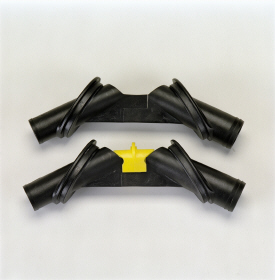 Manifold nozzle and nozzle with cover installed
Manifold nozzle and nozzle with cover installed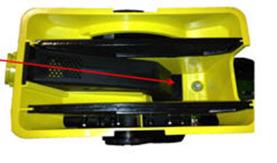 Straight seed inlet installed in mini-hopper
Straight seed inlet installed in mini-hopperCCS seed delivery system increases planting productivity across the approved crops listed above. While highly effective delivering seed from the CCS tanks to the vacuum meters, small or light seeds require two additional components to aid in proper seed delivery.
Manifold nozzle covers (clips) should be installed to ensure seed is adequately picked up into the air stream for delivery to the row-unit. Mini-hopper discharge elbows should also be changed from the standard elbow (holes) to the small seed elbow (slotted openings) when planting sorghum (milo) and small cotton.
Downforce system options
Individual Row Hydraulic Downforce (IRHD)
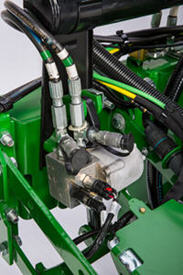 IRHD system
IRHD systemIRHD has been specifically designed to meet the needs of producers that are looking to adjust to the toughest field conditions and provide maximum yield potential from field to field, season after season. IRHD works as a closed-loop downforce system that reacts quickly on an individual row basis to changing soil conditions supporting increased ground contact, which can lead to improved seed depth consistency. When setting planter downforce margin, the system will apply the needed downforce by row to maintain ground contact.
The system allows operators to maintain gauge wheel ground contact leading to desired seed depth placement. IRHD can adjust five times per second and make adjustments of 45.4 kg (100 lb) in less than a second. The system has a total range of applied downforce from 22.7 kg (50 lb) to 204.1 kg (450 lb) and utilizes the power beyond circuit on the tractor. IRHD is 58 percent faster than the active pneumatic downforce solution. Fast reaction and increased ground contact can lead to improved emergence. With uniform emergence, some studies have shown a yield impact from 5 percent to 9 percent.
IRHD is controlled through the G5 Display with SeedStar 5. As shown below, operators can view ground contact or applied downforce using the toggle button.
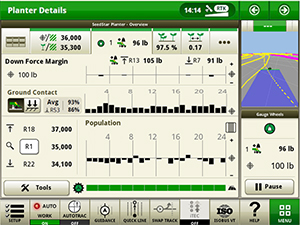 IRHD screen showing the ground contact graph
IRHD screen showing the ground contact graph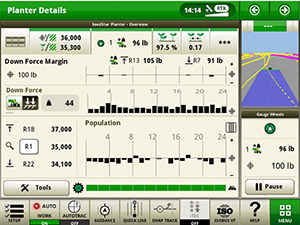 IRHD screen showing the applied downforce graph
IRHD screen showing the applied downforce graphIRHD accumulator
 IRHD accumulator
IRHD accumulatorThe IRHD actuator is the foundation of ensuring accurate seed depth and seed-to-soil contact at higher planting speeds up to 16.1 km/h (10 mph). The newly redesigned IRHD actuator was designed with durability and optimal performance in mind. Consisting of a valve, pressure sensor, cylinder, and now, two accumulators, the new design allows the operator to reduce downtime with recharges instead of replacements. With two rechargeable nitrogen accumulators built into the new IRHD actuator, it maintains performance, even at low nitrogen levels. This allows reduced downtime for the operator, and optimal performance over entire operating range. Pressure control from the IRHD actuator ensures optimal system performance by dampening shocks from field obstacles while operating in the field. The reduction of shock loads prevents excessive wear and broken row unit components due to the new robust and durable design. Frequently worn parts such as the accumulator pistons and seals can be replaced. The actuator rod has an internal retention feature to prevent oil loss in the event of a row unit failure.
Heavy-duty parallel arm for IRHD Planter row units available
 Downforce and margin example
Downforce and margin example- A - Margin – amount of additional downforce applied to a row-unit above and beyond what is required for penetration to achieve planting depth. This additional weight will ride on the depth gauge wheels.
- 54.4 kg (120 lb) + 36.3 kg (80 lb) = 90.7 kg (200 lb) – 68 kg (150 lb) = 22.7 kg (50 lb) of margin
- B - Weight of row-unit - 54.4 kg (120 lb)
- C - Downforce – force that is applied to the row-unit by the air bag circuit - 36.3 kg (80 lb)
- D - Resistance from soil - 68 kg (150 lb)
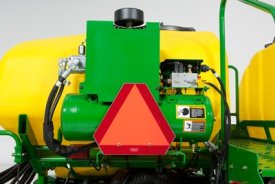 Active downforce compressor assembly
Active downforce compressor assemblyA hydraulically driven compressor works with the G5 Display with SeedStar 5 systems to automate downforce control. Just set the row-unit target margin value and the active pneumatic downforce system works automatically. The system will make sure the planter maintains this value, achieving precise soil penetration, and consistent planting depth, without sidewall soil compaction. From the factory, the system is set at 45.4 kg (100 lb) target downforce margin but may be modified for varying field conditions. This frees the operator from constantly making manual downforce adjustments as conditions change.
This system offers a split-rank control feature for 1795 and DB Split-Row Planters. On split-row planters, active downforce will control the front and rear rows independently. This compensates for differing downforce requirements between the ranks that can be caused by things like different tillage or insecticide attachments and will help maintain an accurate planting depth and consistent margin across all the rows.
Active pneumatic downforce is available as factory installed or as an attachment for field conversion.
Set point row-unit downforce
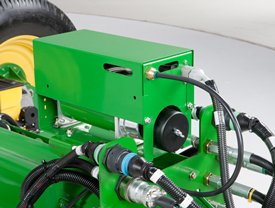 Air compressor mounted on 1775NT outer hitch
Air compressor mounted on 1775NT outer hitchOn set point, the air compressor will be mounted on the outer hitch or frame assembly. Since the electric air compressor assembly is mounted on the outer hitch (as noted in the picture above) or frame, adjustments for row-unit downforce and related system pressures will be made electronically with the display.
When adjusting the amount of row-unit downforce using the display, the operator will select the amount of downforce (kg [lb]) to be applied across the planter. Depending on the soil conditions at hand, the operator might need to adjust the relative amount of row-unit downforce being applied during the planting operation. The integrated pneumatic downforce controls within the display will only allow for set-point operation and not automatic control as the planter is operating in different soil conditions. The pneumatic downforce system does not have the capability to automatically adjust downforce.
Pneumatic downforce provides convenient, simple adjustment of downforce for the whole planter from one location. The amount of downforce applied is infinitely adjustable from 6.8 to 181.4 kg (15 to 400 lb). Pneumatic downforce provides more consistent downforce throughout the range of row-unit travel than mechanical spring downforce systems.
Features include:
- 9.5-mm (3/8-in.) air delivery line instead of the 6.4-mm (1/4-in.) line used on model year 2010 and older planters.
- Air compressor assembly increased duty cycle. With this compressor, it provides a 47 percent increase in maximum air flow delivery compared to the prior air compressor.
- Pneumatic air bags with 9.5-mm (3/8-in.) air line inlets that have greater durability.
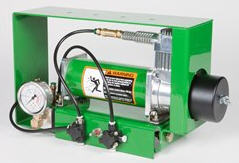 Pneumatic downforce compressor and gauge
Pneumatic downforce compressor and gaugeAn improved compressor is used to charge the pneumatic system. This compressor can be located on the planter frame or in the tractor cab if desired. A gauge at the compressor indicates the amount of downforce being applied.
Integrated pneumatic downforce system
The functional features of the integrated system are the same as the standard pneumatic system, explained above, with the addition of control through the display.
Heavy-duty adjustable downforce springs
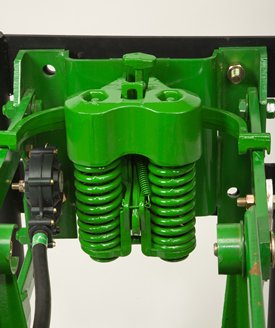 Heavy-duty adjustable downforce spring
Heavy-duty adjustable downforce springPlanter row-unit downforce is an important factor to ensure consistent and proper depth control. The heavy-duty adjustable downforce feature provides up to 181.4 kg (400 lb) of downforce. There are four settings available to allow the operator to choose the amount of downforce required for the condition: 0 kg (0 lb), 56.7 kg (125 lb), 113.4 kg (250 lb), and 181.4 kg (400 lb).
Easy Adjust row cleaners
 Coulter combo row cleaner
Coulter combo row cleaner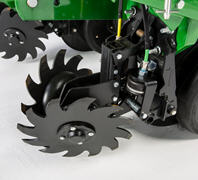 Easy Adjust row cleaner
Easy Adjust row cleanerEasy Adjust row cleaner and coulter combo provides a pneumatic row tillage solution that is controlled from the seat of the tractor.
Every decision to make an adjustment during spring planting reduces the acres planted per day and can increase or decrease profitability. An adjustment that can be overlooked is row cleaners due to planter size, difficulty to make the adjustment, and varying conditions across fields and time.
With the Easy Adjust row cleaners on ExactEmerge™ planters, operators now have a pneumatic solution to make on-the-go adjustments that is controlled directly from the seat of the cab. They can be raised from the cab as needed with the push of a button for wet areas, waterways, or end rows.
The Easy Adjust row cleaners have the capability to save three presets for varying ground engagement based on field conditions. The system is controlled in three sections: at each wing as well as the center (frame or wheel) track rows. The pneumatic lines use air from the active pneumatic downforce compressor, requiring no additional compressor to be installed on the planter. The Easy Adjust row cleaners utilize down and up force air bags. The adjustable air pressure setting for each bag allows the operator to set the ride of the row cleaner depending on the field conditions and the desired results. Making these on-the-go adjustments from tractor cab increases productivity and performance during planting.
For Easy Adjust row cleaner Precision Upgrade options, see the ordering guide.
The row cleaner-only option utilizes parallel linkage to provide the floating action growers require in their fields. Parallel linkage allows for the unit to float up and down in the situation of hills or hard objects. The cleaner and coulter combo does not have parallel linkage, however, the row cleaners have floating rings installed to help provide the same benefits.
The row cleaners utilize the field-proven SharkTooth® design. Row cleaners play a major role in maximizing yield toward uniform emergence, reducing row-unit bounce, and maintaining proper depth. The Easy Adjust row cleaners provide growers with quick and stress-free solutions to customizing the planter in variable field conditions. They are available on most ExactEmerge and MaxEmerge 5e equipped planters.
SharkTooth is a trademark of Yetter Manufacturing Incorporated.
Mobile row-unit runoff
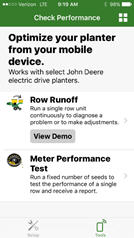 Row Runoff diagnostic test
Row Runoff diagnostic test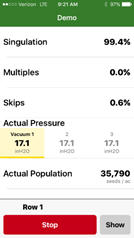 The test functions from a mobile device
The test functions from a mobile device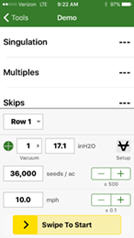 Determine optimum settings without being in the cab
Determine optimum settings without being in the cabThe first day of planting season can be as productive as the last with mobile row-unit runoff. The mobile row-unit runoff activation on the planter main controller (PMC) allows operators to make adjustments to maximize row-unit performance from a mobile device at the rear of the planter for both preseason and in-season use - all enabled through the Equipment Mobile app.
Mobile row-unit runoff allows growers to perform test-stand functions from a mobile device connected to the planter.
The row runoff test provides complete diagnostic checks both preseason and in season. With the row-unit runoff test, the operator can make adjustments from the mobile device, including vacuum pressure, to determine the optimum meter and vacuum settings. This app functionality will help avoid making trips to the cab while validating meter performance.
During preseason planter inspections and set up, utilize the meter performance test to validate meter accuracy, similar to a test stand without leaving the farm. Test all systems on the planter, not just the meter, providing confidence that all planter systems are ready to plant. Reports are generated from the test providing information the operator can save and send for future reference.
Before heading to the field, the operator will benefit from knowing the best row-unit and vacuum settings for each variety selected to plant that spring.
See mobile row-unit runoff in action by watching the "How to Use Mobile Row-Unit Runoff" video.
Mobile row-unit runoff will work with any model year 2015 or newer ExactEmerge™ or MaxEmerge™ 5e equipped planter. Mobile row-unit runoff can be added with attachment AA93169.
For model year 2018 and newer ExactEmerge planters, mobile row-unit runoff is included in base equipment. For model year 2020 and newer MaxEmerge 5e planters, mobile row-unit runoff is included in base equipment. For planters not equipped from the factory, mobile row-unit runoff can be added with attachment AA93169. A mobile row-unit runoff and Easy Fold package can be added with attachment AA97849 (only available with 1775NT and 1795 Planters with a 2-point hitch and model year 2019 and newer DB Planters with Gen 4 based frame folding).
NOTE: Mobile runoff utilizes the Equipment Mobile app available on select iPad® tablets, iPhone® smartphones, and Android™ devices.
Mobile row-unit runoff and Easy Fold aftermarket for field conversion kits
The below software bundles include the functionality explained above for machines not ordered with the feature from the factory. Compatible machines include all the necessary sensors and harnesses needed to make the feature function. The attachment part is software only. Follow the mobile runoff ordering and software push guide below for ordering and installation.
Mobile runoff ordering and software push guide
iPad and iPhone are trademarks of Apple Inc. Android is a trademark of Google LLC.
Achieve accuracy with curve compensation
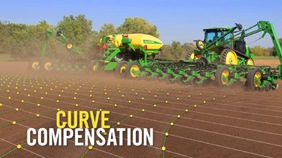 Curve compensation with planters
Curve compensation with plantersTerraces or waterways are two of many field obstacles that make planting on a curve challenging. When planters utilize drive shafts, they are not able to control each individual row-unit; as a result, planting on a curve presents an issue of maintaining 100 percent population. Since the inside rows are moving slower than the outside rows, the inside rows will be overpopulated while the outside rows are underpopulated.
With ExactEmerge™ planters and equipped MaxEmerge™ 5e planters, the curve compensation feature allows each row to receive an individual signal based on the speed at which the row-unit is moving, maintaining the correct population across the width of the planter. Without curve compensation, there could be as much as a 24 percent drop in population accuracy, which is equivalent to 8,600 seeds per acre when planting at 36,000 seeds per acre. Curve compensation measures acceleration within the main planter controller and utilizes speed inputs to ensure each row has the desired population accuracy.
SeedStar 5 enables new planting technology
 SeedStar 5 screen example
SeedStar 5 screen exampleOverview
SeedStar 5 is the latest monitoring software for John Deere planters available for Model Year 2025. This system is paired with G5 displays and Implement Ethernet to provide high-definition documentation, faster data speeds, and more information in the cab.
Benefits
- Faster data speeds
- High Definition (5Hz data) documentation
- Enables new technology like ExactShot and FurrowVision
- Building block for future planter automation
Additional details
Requirement:
- G5 Display
- Planter Implement Ethernet (included on model year 2025 planters)
- Building block for future planter information
